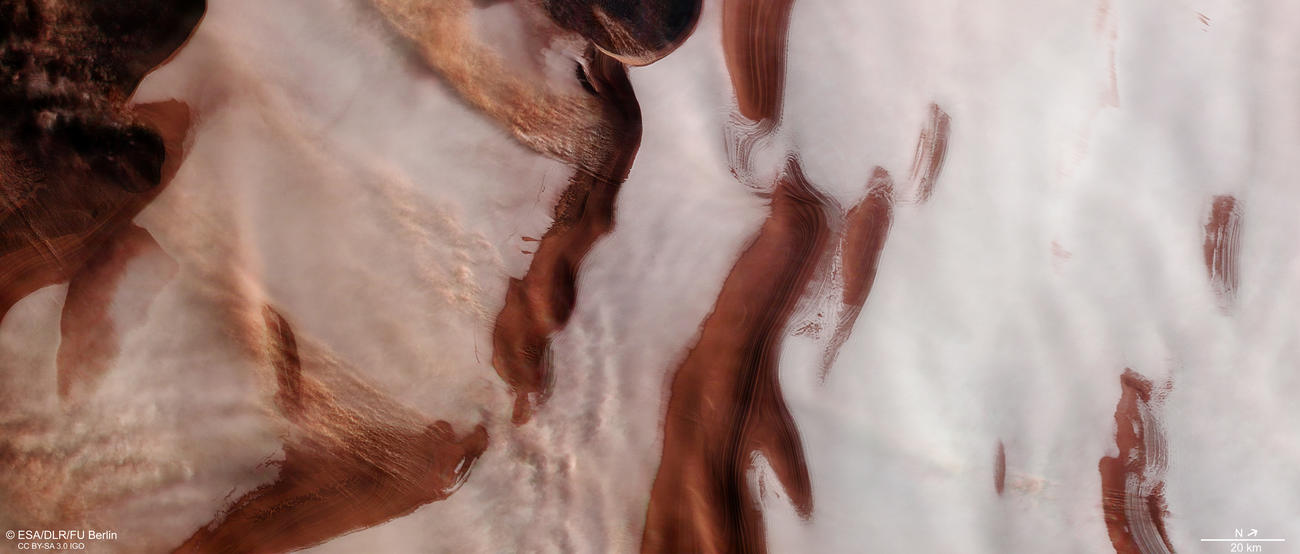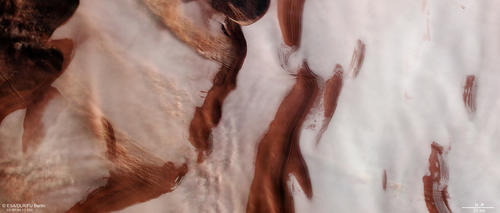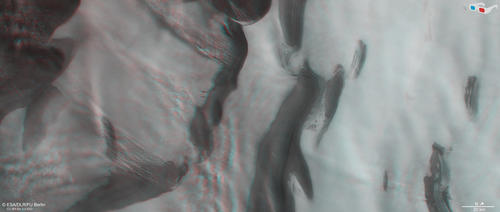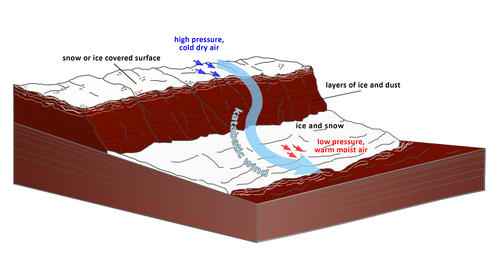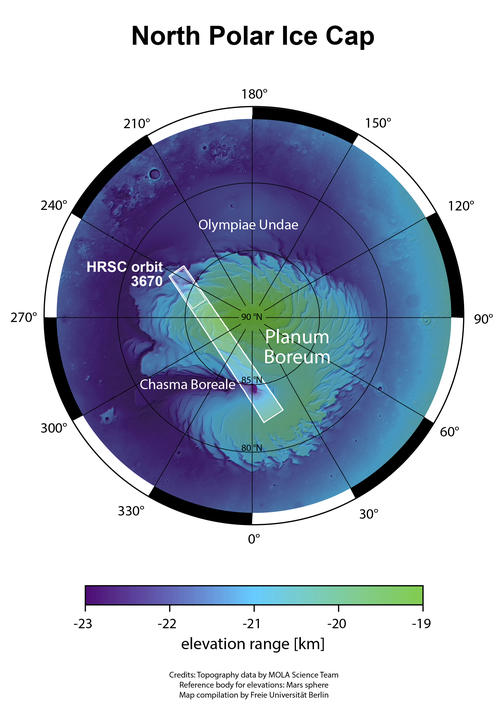Department of Earth Sciences
Service Navigation
Cloud Formations at the North Polar Ice Cap of Mars
This week the Seventh International Conference on Mars Polar Science and Exploration takes place in Ushuaia, Argentina. Active processes at the Martian poles are of great interest to the science community. The observation of atmospheric phenomena and geologic developments operating on Mars today is one of the main goals of the High Resolution Stereo Camera (HRSC) on board ESA’s Mars Express mission. A rare observation with HRSC recorded during Martian summer 2006 shows seasonal dust clouds in relation to the spiral troughs of the north polar ice cap of Mars.
» read more in the main article and below the gallery....
Cloud Formations at the North Polar Ice Cap • Images
HRSC color image
Image Credit: ESA/DLR/FU Berlin
HRSC anaglyph
Image Credit: ESA/DLR/FU Berlin
North Polar Ice Cap • Location
context map
Image Credit: MOLA Science Team/FU Berlin
Impressive Cloud Formations
» read more about the Mars Polar Ice Cap
The north polar ice cap of Mars changes its face during the course of the year: a permanent cap composed mainly of water ice is observed in the summer season, as shown in this HRSC image. During the winter season, temperatures fall below -125 degrees Celsius, cold enough for carbon dioxide to precipitate and build a thin (1-2 meters) seasonal polar cap of carbon dioxide ice. At this time of the year, the ice cap is often covered by thick carbon dioxide clouds and thus difficult to observe with cameras from orbit.
The darker troughs in between the shining white water ice deposits are part of an impressive system of depressions that spiral outwards from the pole center in a counterclockwise direction and cut through the thick stack of layered deposits that make up the north polar cap. These layered deposits are composed of ice intermixed with dust and record the evolution of the Martian climate over the last Millions of years.
The clouds on this HRSC image have been interpreted as small local dust storms aligning perpendicular to the troughs. Local dust storms were also frequently observed in THEMIS and HiRISE data, especially at the equator-facing walls of the polar troughs. This kind of dust mobilization could facilitate scarp erosion and retreat. Both sublimation and katabatic wind erosion seem to be important active eolian processes responsible for the long-term modification of the trough walls.
Wind erosion could be the driving force for the formation of the spiral troughs, as suggested by the analysis of radar data. One theory is that the spiral troughs are cyclic steps formed by katabatic winds blowing over ice. A katabatic wind denotes a downslope gravity flow of cold, dense air. It often initiates on higher-elevation areas with cold dry air, e.g. glacial or snow-covered plateaus, and flows down to lower-elevation areas such as valleys hosting warm, less dense air. In the case of the Mars polar cap, air movement is occurring radially away from the pole, and additionally controlled by Coriolis forces that lead to a spiral path of the flow.
High Resolution Stereo Camera (HRSC)
» information to image origin and processing
The images were acquired by the HRSC (High Resolution Stereo Camera) on 16 November 2006 during Mars Express Orbit 3670. The ground resolution is approximately 15 meters per pixel and the images are centered at about 244° East and 85° North. The color image was created using data from the nadir channel, the field of view which is aligned perpendicular to the surface of Mars, and the color channels of the HRSC. The anaglyph, which provides a three-dimensional view of the landscape when viewed using red-green or red-blue glasses, was derived from data acquired by the nadir channel and the stereo channels.
HRSC is a camera experiment that was developed and is operated by the German Aerospace Center (Deutsches Zentrum für Luft- und Raumfahrt; DLR). The systematic processing of the camera data took place at the DLR Institute for Planetary Research in Berlin-Adlershof. The working group of Planetary Science and Remote Sensing at Freie Universität Berlin used the data to create the image products shown here.
To download released raw images and DTMs of the region in GIS-ready formats, follow this link to the mapserver.
Images: ESA/DLR/FU Berlin, CC BY-SA 3.0 IGO
Copyright Notice:
Where expressly stated, images are licenced under the Creative Commons Attribution-ShareAlike 3.0 IGO (CC BY-SA 3.0 IGO) licence. The user is allowed to reproduce, distribute, adapt, translate and publicly perform it, without explicit permission, provided that the content is accompanied by an acknowledgement that the source is credited as 'ESA/DLR/FU Berlin', a direct link to the licence text is provided and that it is clearly indicated if changes were made to the original content. Adaptation / translation / derivatives must be distributed under the same licence terms as this publication.
Die High Resolution Stereo Camera wurde am Deutschen Zentrum für Luft- und Raumfahrt (DLR) entwickelt und in Kooperation mit industriellen Partnern gebaut (EADS Astrium, Lewicki Microelectronic GmbH und Jena-Optronik GmbH). Das Wissenschaftsteam unter Leitung des Principal Investigators (PI) Prof. Dr. Ralf Jaumann besteht aus 52 Co-Investigatoren, die aus 34 Institutionen und 11 Nationen stammen. Die Kamera wird vom DLR-Institut für Planetenforschung in Berlin-Adlershof betrieben.
